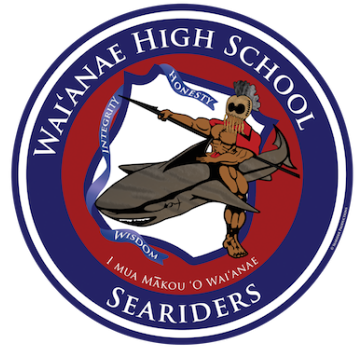|
OUR MISSION is to build a collaborative learning environment and a culture that emphasizes: Leading with ALOHA Responsibility for myself and my community Resilience in the face of challenges Innovation and complex thinking Communicating effectively Empowering each other for excellence |
OUR VISION is that ALL students will graduate with a commitment to a post-secondary school, join the military, or possess a written employment offer/plan. Together we are Waianae Strong! |
PRINCIPALS MESSAGE
~ Ray Pikelny-Cook, Principal
~ Ray Pikelny-Cook, Principal
|
SCHOOL DESCRIPTION Waianae High School is located on the Leeward Coast of Oahu, 35 miles from Honolulu. Waianae High School students come from the rural communities of Maili, Waianae and Makaha. The Nanakuli and Waianae Complexes (which include Waianae High School and our feeder schools) are targeted to be part of the Zone of School Innovation (ZSI) under Hawaii's Race-To-The-Top (RTTT) educational reform model. Schools in the ZSI will be required to implement Hawaii's RTTT initiatives. Waianae High School is in the process of redesigning our academy structure to meet the 21st century needs of our students, and is working towards providing more personalized education, more rigor and relevance in our classrooms, increasing parent communication and involvement, and fostering and supporting a professional learning community for teachers and staff. To support this vision, Waianae High School's academy structure promotes a smaller learning community (SLC) philosophy beginning with our Ninth Grade Success Academy (NGSA) for all incoming 9th grade students. The SLC support structure continues into 10th grade as students move into either our Sophomore Academy or into the Searider Productions Academy – a New Tech Network School. Two career academies service WHS's upper grade students. Upper grade career academies are organized into the following areas of student interest: Natural Resources/Arts & Communication (NR/AC), and the Business, Industrial, Engineering and Technology/Health and Human Services (BIET/HHS) academies. Waianae High School uses a 4x4 block schedule to accommodate student needs and interests. The 4x4 block also provides students with opportunities to participate in Running Start and early admission courses as college credit options. Waianae High School was accredited by the Western Association of Schools and Colleges for a period of three years with a mid-term review. This school's accreditation term expires in 2014. |
ADDRESS
85-251 Farrington Hwy. Wai'anae Hi. 96792 Phone 808-697-9400 Fax. 808-697-7018 |
GLO's
General Learner Outcomes (GLOs) are the over-arching goals of standards-based learning for all students in all grade levels. Observable behaviors, which are demonstrated in daily classroom activities, are evidence of GLOs. Student effort, work habits, and behavior are important and they must be evaluated separately from academic performance in the content areas (in accordance with Board of Education Policy 4501: Assessing/Grading Student Performance).
The GLOs should be an integral part of the school culture as the GLOs do not exist in isolation. The six GLOs are:
The GLO rubric serves as a guideline for teachers and students. Elementary teachers use this rubric and classroom-based evidence to determine a student's rating for each GLO, which is then communicated to parents via the elementary standards-based report card. Secondary teachers incorporate the GLOs into their content instruction, however, as of July 2009 the secondary report card does not include a GLO assessment.
General Learner Outcomes (GLOs) are the over-arching goals of standards-based learning for all students in all grade levels. Observable behaviors, which are demonstrated in daily classroom activities, are evidence of GLOs. Student effort, work habits, and behavior are important and they must be evaluated separately from academic performance in the content areas (in accordance with Board of Education Policy 4501: Assessing/Grading Student Performance).
The GLOs should be an integral part of the school culture as the GLOs do not exist in isolation. The six GLOs are:
- Self-directed Learner (The ability to be responsible for one's own learning)
- Community Contributor (The understanding that it is essential for human beings to work together)
- Complex Thinker (The ability to demonstrate critical thinking and problem solving)
- Quality Producer (The ability to recognize and produce quality performance and quality products)
- Effective Communicator (The ability to communicate effectively)
- Effective and Ethical User of Technology (The ability to use a variety of technologies effectively and ethically)
The GLO rubric serves as a guideline for teachers and students. Elementary teachers use this rubric and classroom-based evidence to determine a student's rating for each GLO, which is then communicated to parents via the elementary standards-based report card. Secondary teachers incorporate the GLOs into their content instruction, however, as of July 2009 the secondary report card does not include a GLO assessment.





